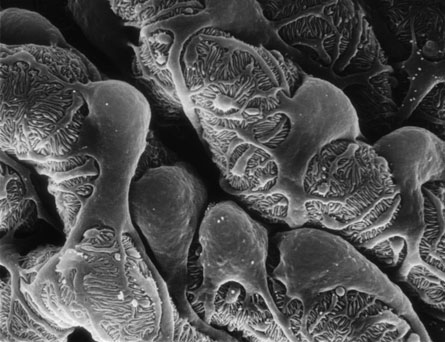Getting to the bottom of diabetes and kidney disease
Renal cells called podocytes may need insulin to maintain blood-filtration role
Diabetic kidney disease may result as much from a failure of certain renal cells to access insulin as it does from runaway blood sugar, a new study shows. The findings in mice suggests that targeting the condition known as insulin resistance might protect the kidneys of people with diabetes, researchers report in the October Cell Metabolism.

Fully half of all kidney disease that leads to dialysis or a transplant occurs in people with diabetes, and most have the common type 2 form that typically shows up in adulthood. Type 2 diabetes has clear links to obesity, lack of exercise and insulin resistance in which cells fail to capture glucose efficiently from the bloodstream after digestion of food. While the precise cause of insulin resistance remains unclear, there’s no question it starves cells, forces the pancreas to work overtime making more insulin and leaves a person with high blood sugar.
In the new study, researchers investigated a role for insulin resistance in kidney failure by examining cells called podocytes that form part of the blood-cleansing apparatus of the kidneys. Podocytes look like miniature octopuses layered over capillaries in the kidneys, with extensions that snag useful proteins from blood but allow water and waste products to pass through and into the urine. “It’s a biological sieve,” says pediatric nephrologist Richard Coward of the University of Bristol in England.
Since earlier research had suggested that podocytes might be sensitive to insulin, Coward and his colleagues suspected that insulin resistance might damage these filtration cells and therefore underlie kidney damage common to people with diabetes. To test that hypothesis, the team genetically engineered mice to have podocytes lacking insulin-receptor proteins. In these mice, podocytes were largely unable to bind to insulin needed to orchestrate the use of glucose in the cells. Within several weeks the animals showed damage to the podocyte “tentacles,” allowing leakage of albumin proteins into the urine. Such albumin loss is a telltale sign of kidney problems, Coward says.
Podocytes unable to use insulin also eventually showed increased cell death and accumulation of compounds such as collagen, the effects of which are still being investigated by the researchers.
Coward says this damage showed up even though the mice didn’t have high blood sugar, or hyperglycemia, suggesting that insulin resistance plays a role in kidney disease brought on by diabetes, a condition called diabetic nephropathy.
“This paper turns some of the thinking about diabetic nephropathy on its head,” says Sian Griffin, a nephrologist at the University Hospital of Wales in Cardiff. “Previous treatment has focused on optimizing glycemic control, but these experiments suggest a potential novel therapeutic paradigm — that diabetic nephropathy might be prevented or even reversed by targeting the podocyte insulin-signaling pathway in itself.”
What’s more, says nephrologist Alessia Fornoni of the University of Miami in Florida, “it’s never been clear that the kidney even needed to sense insulin at all.” While it’s been well understood that muscle and liver cells use insulin, for example, the demonstration that kidney cells are able to use it “is very novel,” she says.
The findings also paint a picture of the kidneys as dynamic organs. “We’ve always thought about the kidneys as a static barrier,” Fornoni says. “But when you think about it, practically all the protein we take in will eventually pass by the kidneys and stress out the filtration barrier.”
Coward theorizes that insulin energizes podocytes to prepare them for such stress. “After a meal you get a rise in insulin from the pancreas but also a rise in filtration rates in the kidneys,” he says. The drugs pioglitazone (sold as Actos) and metformin (originally Glucophage) have some effect on insulin resistance, Coward notes. But the drug most specifically targeting the condition — rosiglitazone (Avandia) — has run into problems recently as regulators restrict its use while assessing its safety.







